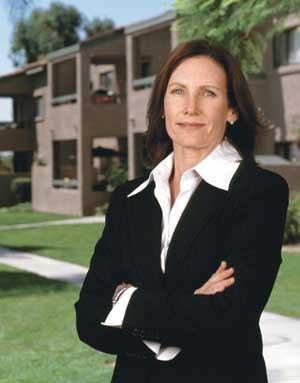Building Blocks Cleaning up a property may be a tough challenge, but it can be even harder for SoCal Housing to gain the neighborhood’s trust. Residents are skeptical that the nonprofit will live up to its promises and help improve the neighborhood. They are also plain scared. “
At many of our ethnically diverse communities, fear and distrust of the landlord is prevalent,” says Gloria Elisa Chavez, director of communications at SoCal Housing. “In the past, residents were told that if they complained about maintenance issues, [the previous landlords] would call immigration on them. We have to really work with residents and show them that we want them to report maintenance issues and any other problems that they might have.”
Even though SoCal Housing attempts to lower rents when it takes over a property, residents worry that they will be kicked out, relocated, or forced to move by higher rents. “They know that the property isn’t the best when we take it over,” explains Clark. “The fear is that they are going to be evicted or that we will fix it up and then raise the rents.”
That was the case at Cobblestone Village in Escondido, Calif., where residents feared that already-high rents were going to be raised. The community was acquired in the fall 2000, and the rents for the community made up of three-bedroom units were approximately $900. By the time the units were renovated and the project complete in late summer 2002, rents in the San Diego County market rose approximately 25 percent. However, SoCal Housing stabilized rents at Cobblestone Village, which currently range from approximately $270 to $946.
When it comes to gaining community approvals, SoCal Housing follows a recipe for success. “Our best sales pitch is showing them what we’ve done,” says Clark. Williams agrees, adding that “If you drive through the city, I would challenge someone to tell the difference between the subsidized projects and the market-rate multifamily,” she says.
But SoCal Housing knows that there is a lot more to community approvals than that. Its strategy starts with gaining a commitment from the political leadership. Next, the company listens. “You need to let community members air out everything they have to say, because they feel like they have to say it,” says Chavez. “Then we come back with ideas incorporating what they said.”
When appropriate, SoCal Housing encourages the formation of advisory boards that include community members – not just figureheads. “A lot of people [in the industry] don’t want to give them power, but it is really effective,” explains Chavez. “At Hermosa Village in Anaheim, Calif., the advisory board was essential in getting the community to support this project.”
The next step is forming strong media relationships. “A lot of local journalists are sympathetic to our cause because they live in apartments and they don’t like people saying that [renters] are second-class citizens,” notes Chavez.
Finally, the company is committed to perseverance. “Building affordable housing is a long-term commitment,” she says. “We have to keep at it. It doesn’t happen over night.”
